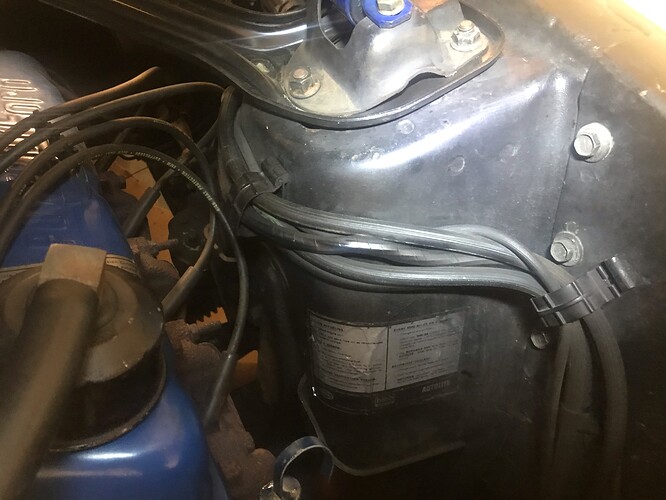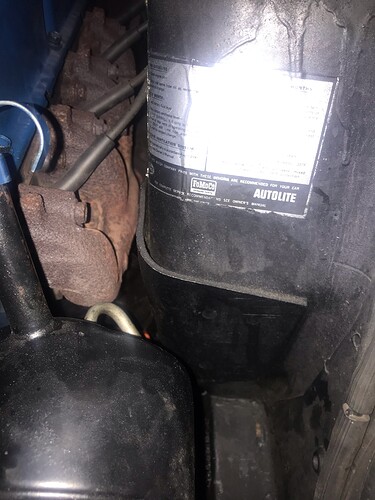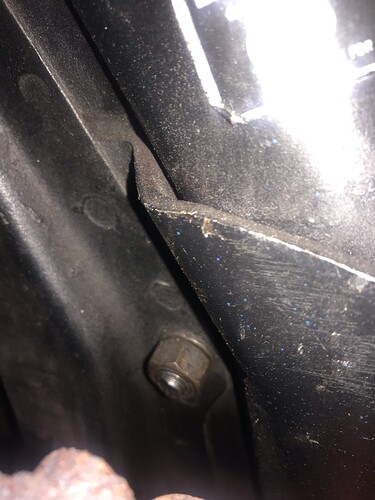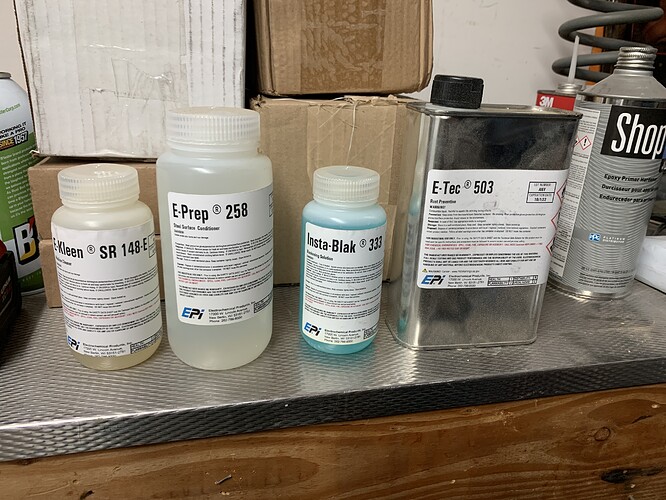I’m trying to figure out the original finish on front shock brackets and hardware.
Thanks Mike. Is the bracket natural finish? The inner fender bolts looks silver. Are these the original bolts?
As far as I know they are original, there was very little restoration done before I bought the car…but the blue flecks tell me something was done under the hood.
Not sure what a natural finish is. There is a slight chip above that nut that has rusted, so they were coated/painted with something. As mentioned the finish on the bracket and shocktower itself appears the same. ![]()
The finish depended on where the car was built and in turn the supplier for that particular plant
Dearborn would be phosphate and oil while San Jose would be semi-gloss black
Thanks J. You seem very knowledgeable. My R code cougar was produced in Dearborn 9/23/68. I’m also trying to determine correct finish for top fender, inner fender and reinforcement brace( export brace). From looking at photos of restored cars I see a lot variation . I appreciate your help on this.
My understanding is a natural finish is a just bare metal coated with a product called natural finish that is clear coat of some type.
" fps wrote:
My understanding is a natural finish is a just bare metal coated with a product called natural finish that is clear coat of some type."
No. Guess you read this or someone posted this using a term or phrase borrowed from one of the judging rules. Guessing it originated from MCA (Mustang Club of America) that you saw. This is a poor short hand method of describing any finish that was not painted. Could be bare steel, heat treated steel, zinc, cad, … plating or coated and even dyed. Leads allot of people in the wrong direction unless additional details are included beyond the short description.
The finish for a Dearborn would have been phosphate and oil as mentioned above and the same finish as things like hood hinges, hood springs, hood latch and others…
I likely have dozens of examples from original car pictures in my collection. Mustangs and Cougars were built on the same line and shared this part between both models
fps wrote:
“… My R code cougar was produced in Dearborn 9/23/68. I’m also trying to determine correct finish for top fender, inner fender and reinforcement brace( export brace).”
Since you are doing a 69 Dearborn some of the parts at the front end of the car were painted with a “slop” paint while the same pieces were painted black on San Jose built cars the same year. Sorry if I screw up on one of these since I’m working more from the Mustang side and may make a mistake while I try to remember what parts both cars share
They included
The front spring covers in the front wheel wells
Battery tray
Shock tower supports (cowl/firewall to shock tower braces)
Convertible floor reinforcement plate
Not sure if these were slop also - thy might be since the might have been produced by the same provider as the Dearborn Mustang parts
Front license plate bracket ?
Hood latch support ?
Lower front fender to front frame.?
Inner front bumper arms/support?
Think that is it.
This slop gray can take on many different tones and tints since it is believed this was a mix of left over/recycled paint mixed with a base. In a similar way as we find on the undercarriage of 69 Dearborn built cars from the firewall rearward on the majority of cars.
The paint color can take on the look of a dark gray with a slightly blue or greenish tint to almost a solid black. Also consider that since all these parts were made and painted on different days at different locations the likely hood that they would all be the exact some color is doubtful
Hope this helps
Thanks Again Jeff. I realize that most bare appearing metal had to have been treated in some way. Example is the power steering pump bracket is not painted but must have been treated or would be total rust covered. Do you know what these were treated with. The engine Bay Area seems to have been originally painted a satin black. I did see some gray on parts of rear undercarriage were the likely dealer undercoat is coming off.
So, in your next to last post on this topic are saying that the shock tower brackets are phosphate/ oil. What are the top fender bolts, inner fender bolts and miscellaneous bolts and screws. I may not have been clear about the bolt finish.
I understand when you were young you worked at the local drag strip and your father raced in various classes.
I was the first owner of the cougar I just purchased back this past September. It hooked me on drag racing for 40 years. I’m now the 4th owner too. I ran F/pure stock back in 69 and won top eliminator 7 consecutive weeks at Peterson memorial Dragway in Tipton pa. It was tuff with usually over 20 plus cars just in F pure stock. And then run all the other class winners. I sat down with the factory representative and ordered this car with the intention of racing it. It had a great HP rating. I was just 19 years old. This cougar is 1 of 26 2dr hardtop 428 CJ ram air 4spd with red paint and white interior.
Dave
I used a product from EPI called Insta-blak 333. It simulates the phosphate/oil finish (in my opinion). You can get a sampler for around 50 bucks and it’s enough to do most everything you will need.
I also saw a video of how use black oxide concentrate. A bottle costs about $35. Depending how you clean the object it will produce different finishes. Wire wheel will be more glossy. glass beading will produce a more flat finish.
If you’re looking for a phosphate oil finish I highly recommend you use phosphate and oil. It’s a safe simple process.
Insta black is the best way to go. Be sure to dilute to 50% strength with water. The process is simple. Dip the part, let sit in the solution for a minute or 2. Remove, wash with clean water, force air dry (to prevent flash rusting), then oil immediately. I like to use Boe-shield, spray the parts and let it air dry. The oil turns into a waxy protection layer, you can wipe the parts down the next day.



